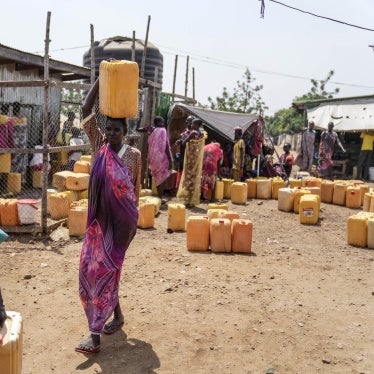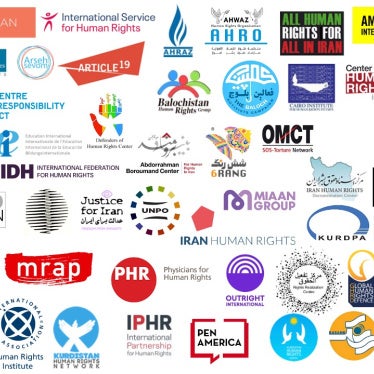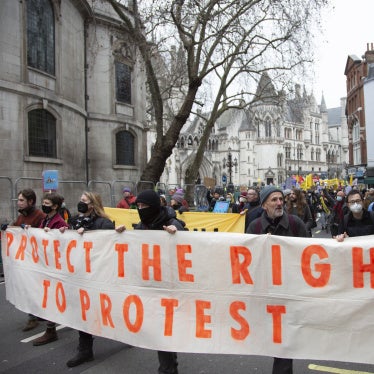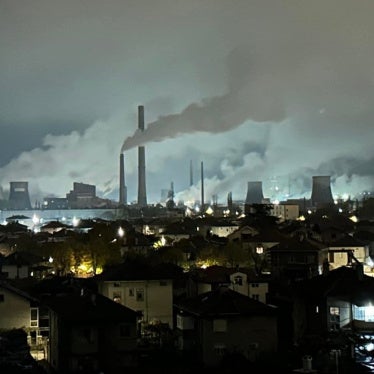This submission relates to the review of Kenya under the African Charter on the Rights and Welfare of the Child. It focuses on the right to education, the protection of students, teachers, and schools in situations of armed conflict, and sexual violence against children during Kenya’s volatile election periods.
Barriers to the Right to Primary and Secondary Education (article 11)
Human Rights Watch has found that the government of Kenya does not guarantee the right to free primary and secondary education; and that it has not yet ensured all children, particularly girls, can stay in school.
Barriers due to Pregnancy, Motherhood
In Kenya, students who are pregnant or adolescent mothers face serious barriers to continuing their education. Human Rights Watch published research in July 2018 on pregnant students’ and adolescent parent’s right to primary and secondary education in all African Union (AU) member countries. Kenya is among the group of 27 African countries that have adopted laws, “continuation” or “reentry” policies, and national strategies, to ensure that pregnant students can resume their education after giving birth.[1]
Kenya’s 2009 National School Health (NSH) Policy and a ‘School Return’ policy, adopted in 1994, protect students’ re-entry into school.[2] However, Human Rights Watch found that these policies are implemented inconsistently, with very little monitoring by government officials to ensure schools comply with policy guidelines.[3] This turns into multiple barriers faced by students.[4] Our analysis shows that the combination of these policies impose conditions on girls’ right to education.
We particularly found inconsistencies regarding the length of time a student should be absent from school, the processes for withdrawal and re-entry, and the availability of support structures within schools and communities for adolescent mothers to remain in school. We also found widespread lack of understanding amongst teachers, students, education officials and communities about the provisions on reentry for pregnant students.
In Migori county, Human Rights Watch documented instances of school authorities barring pregnant students from attending school.[5] In other cases, students left school early to avoid stigma from peers, teachers and school officials.
Whereas the NSH policy stipulates that a pregnant student and her parents will be counselled on pregnancy-related concerns and the continuation of school, Human Rights Watch found that this did not happen in most cases. Some parents were reluctant to allow their children to go back to school after pregnancy, even though many had not completed primary or lower secondary education. In a few cases, parents preferred to arrange a marriage instead of sending them to school.
Although Kenya’s Basic Education Act No. 14 of 2013 guarantees children have a right to free basic education,[6] Human Rights Watch documented numerous instances where pregnant students dropped out of school and then struggled with financial difficulties, both with expensive school fees and indirect costs for necessary items such as uniforms.[7]
Human Rights Watch notes with concern announcements that schools in Western Kenya were encouraged to perform compulsory pregnancy tests to “crack-down” on teenage pregnancy and female genital mutilation.[8] Mandatory pregnancy testing is a serious infringement of girls’ rights to privacy, equality, and autonomy.
Sexual Exploitation, Harassment and Abuse in Schools
In Kenya, children are exposed to widespread school-related sexual and gender-based violence in schools.[9] Human Rights Watch found some cases of school-related sexual exploitation during its research in Migori County. We interviewed Angela, who was 20 years old and in Form 4, who was sexually exploited by a trainee teacher in her school. He told her he would give her money to register for the Kenya Certificate for Primary Education (KCPE), which cost KES 1200, if she had sex with him. The teacher sexually exploited Angela a number of times, until she found out she was pregnant.[10]
Comprehensive Sexuality Education (CSE)
In Kenya, HIV infections among young people are high, many teenagers are sexually active and adolescent pregnancy rates stand at 18 per cent.[11] Child marriage is also high and is linked to teenage pregnancy.[12]
In 2013, Kenya committed to adopting comprehensive sexuality education,[13] but has failed to implement comprehensive, scientifically accurate, age-appropriate, gender-sensitive sexuality and reproductive education.[14] CSE is mostly taught as part of the compulsory but non-examinable Life Skills curriculum, which teachers often skip to focus on core examinable subjects.[15] Teachers also lack training on how to deliver the subject matter.[16] Opposition to comprehensive sexuality education is strong in the country, with groups affiliated to the Catholic church, religious leaders, and conservative politicians, attempting to block efforts to ensure children receive adequate information and skills in schools.[17]
Human Rights Watch found that children have limited understanding of changes in their bodies and adolescent sexual behavior, prevention of pregnancy and sexually transmitted infections, the menstrual cycle, basic reproduction, and sexual and gender-based violence.[18]
Some girls interviewed by Human Rights Watch were sexually active from an early age, but had no information about how to prevent pregnancy. Most got pregnant following sexual relationships with boys their age. For example, Evelina, 17 at the time of our interview, told Human Rights Watch she hoped she would not get pregnant, but did not use any contraception. She did not know how to prevent pregnancy. She got pregnant just as she finished primary school.
We also found that students received inconsistent information about sexuality and reproductive health in schools. For example, a 14-year-old girl who was pregnant at the time Human Rights Watch interviewed her told us she had learned that, “If you have sex during your periods you can get pregnant. On the other days that you are not on your periods, and you have sex, you do not get pregnant.”
Human Rights Watch recommends that the Committee asks the government:
- What steps are being taken to tackle barriers that lead to low retention of students in school, including school fees, indirect costs and gender violence and discrimination, particularly in rural areas?
- What policy or regulatory measures will the government adopt to fully support pregnant students and adolescent parents’ return and remain in school?
- What steps are being taken to increase coverage of adolescent sexual and reproductive health in rural areas, and ensure students can access these services?
- What measures has the government taken to adopt comprehensive sexuality education (CSE), embed it into the national curriculum, and to ensure schools and teachers are adhering to best practices when teaching CSE as a subject?
Human Rights Watch encourages the Committee to make the following recommendations:
- Adopt a policy to make secondary education fully free of charge;
- Officially and in practice remove school fees and indirect costs in primary and secondary education.
- End mandatory pregnancy testing;
- Ensure that pregnant and married students continue their education, and ensure schools are free from stigma and discrimination. Allow pregnant students or adolescent parents to choose an alternative school should they wish to; and monitor schools’ compliance with the government’s policy.
- Adopt a strong curriculum on comprehensive sexuality and reproductive education, which complies with international standards, is mandatory, age-appropriate, gender-sensitive and scientifically accurate; including information on adolescent sexual and reproductive health and rights, responsible sexual behavior, consent, prevention of early pregnancy and sexually transmitted infections.
Protection of Education During Armed Conflict (articles 11 and 22)
On January 7, 2020, Saretho Primary School, in Garissa County, was attacked by armed militants while around 200 boys and girls were in the school. Four students and one teacher were killed. The other teachers from the school have reportedly since fled the area and the school has been temporarily closed. No one has claimed responsibility for the attack, but the Kenyan government has accused the armed Somali group al-Shabab of carrying out the attack. Between 2013 and 2017, there were almost a dozen al-Shabab attacks on Kenyan schools.[19]
On January 13, 2020, armed militants attacked Kamuthe primary school and killed three teachers while kidnapping another.[20]
Kenya has endorsed the Safe Schools Declaration, an inter-governmental political commitment that provides countries the opportunity to express political support for the protection of students, teachers, and schools during times of armed conflict; the importance of the continuation of education during armed conflict; and the implementation of the Guidelines for Protecting Schools and Universities from Military Use during Armed Conflict.[21]
Human Rights Watch recommends that the Committee ask the government:
- What specific steps are being taken to protect schools from attacks?
- What actions are being taken to retain and protect teachers and other staff following attacks on schools?
- What concrete measures have the Kenyan armed forces taken to deter the military use of schools in contravention of international law, including through its military manuals, policies, trainings, planning, and orders?
Human Rights Watch encourages the Committee to make the following recommendations:
- Congratulate Kenya for endorsing the Safe Schools Declaration.
- Implement the commitments of the Safe Schools Declaration
- Take concrete measure to deter the military use of schools in contravention of international law.
- Encourage Kenya to share any good practices with other countries in the African Union.
Sexual Violence Against Children (articles 16 and 27)
In 2016 and 2017, Human Rights Watch documented the devastating physical, mental, social, and economic impact of gender-based violence and serious human rights abuses following Kenya’s elections.[22] Human Rights Watch research confirms that there was widespread sexual violence against women and girls, in terms of numbers and locations, many carried out by the police.
Sexual violence has impacted women’s and girls’ lives in devastating ways. Many have
experienced injuries or other health and social consequences. Women and girls also experienced profound mental trauma and anguish, describing feelings of hopelessness, self-hatred, fear and anxiety, sleeplessness, and suicidal thoughts. Children born from rape face abuse and neglect in their homes. Human Rights Watch found that some families, relatives, and communities mocked children born from rape, stigmatized them as illegitimate, outcasts, or belonging to the “enemy,” or rejected them along with their mothers. Survivors said their husbands and other family members called them derogatory names.
Only a few of the women and girls interviewed by Human Rights Watch who had been in school at the time of the election violence said they were able to resume their studies following the rape. Some said it was because of the shame of rape, pregnancy and the need to care for the babies, or that they lacked family and financial support to return to school. In other cases, women and girls suffered physical injuries and developed mental health conditions that hindered them from pursuing an education. Young girls said they experience nightmares, lack of sleep, listlessness, fear, and anxiety that limits their ability to study.
One woman interviewed said that her 17-year-old daughter, Peris, and a friend were gang raped together on August 14, 2017. Peris was left for dead, and her friend died following the rape. Her mother now worries about her mental health, and her education. Young girls who were raped were reported to having trouble focusing in school. They said they experience nightmares, lack of sleep, listlessness, fearfulness, and anxiety that limit their ability to study.[23]
Human Rights Watch encourages the Committee to make the following recommendations:
- Investigate the full range of abuses committed by police, and any militias controlled or tolerated, including allegations of sexual violence.
- Adopt a zero-tolerance policy against sexual violence committed by police and other officials and issue a public and clear warning that perpetrators will be prosecuted to the full extent of the law.
- Create and carry out outreach programs to encourage all survivors of sexual violence to seek medical treatment and to report their cases to the police.
- Develop and implement a strategy for civilian protection in times of crisis, including specific measures to protect children against sexual violence.
- Develop and implement a comprehensive reparations program that is in accordance with international standards for all victims of serious human rights violations committed during the election violence.
- Provide free, quality, comprehensive, and survivor-centered medical treatment and psychosocial services for all survivors of rape and other forms of sexual violence, including children and those who have witnessed sexual violence or other forms of violence; and
- Develop programs to address the mental health needs of survivors, including mobile outreach, individual counseling, and support groups, based on the free and informed consent of the individual; this should include programs for girl survivors and for children who witnesses sexual violence.
- Take measures for the protection of children born from elections-related rape, including by publicly condemning discrimination against them in acquiring birth certificates.
[1] “Leave No Girl behind in Africa: Discrimination in Education against Pregnant Girls and Adolescent Mothers,” Human Rights Watch, June 14, 2018, https://www.hrw.org/news/2018/06/14/witness-coming-back-school p. 6.
[2] Population Council, et al, STEP-UP: Education Sector Response to Early and Unintended Pregnancy: A Review of Country Experiences in Sub-Saharan Africa, 2015, https://www.popcouncil.org/uploads/pdfs/2015STEPUP_EducSectorResp.pdf.
[3] “Education for pregnant girls and young mothers,” Health and Education Advice and Resource Team, May 27, 2015, https://assets.publishing.service.gov.uk/media/57a08965ed915d622c0001c9/Education-pregnancy-and-young-motherskenya-nigeria-UK-africa-2.pdf (accessed February 12, 2020)
[4] “Giving Girls a Future: Empowering Pregnant Girls and Adolescent Mothers to Stay in School,” Human Rights Watch multimedia June 14, 2018, https://www.hrw.org/video-photos/interactive/2018/06/14/giving-girls-future
[5] “Coping with Unintended Pregnancies: Narratives from Adolescents in Nairobi’s Slums,” African Population and Health Research Center, April 2014,
https://aphrc.org/wp-content/uploads/2019/07/APHRC-Step-Up-Formative-Report-26.06.2014-Hi-Resolution1.pdf (accessed February 12, 2020)
[6] Republic of Kenya, Basic Education Act No.14 of 2013, revised in 2017, http://ilo.org/dyn/natlex/natlex4.detail?p_isn=94495, arts. 28 and 29.
[7] Audrey Wabwire, “Witness: Coming Back to School,” commentary, Human Rights Watch witness piece, June 14, 2018, https://www.hrw.org/news/2018/06/14/witness-coming-back-school
[8] Rebecca Ratcliffe, “Schoolgirls in Kenya to face compulsory tests for pregnancy and FGM, The Guardian, January 4, 2019, https://www.theguardian.com/global-development/2019/jan/04/schoolgirls-in-kenya-to-face-compulsory-tests-for-pregnancy-and-female-genital-mutilation-narok-county.
[9] Republic of Kenya, UNICEF et al, “Violence Against Children in Kenya – Findings from a 2010 National Survey,” https://www.unicef.org/esaro/VAC_in_Kenya.pdf; Jill Craig, “Violence Against Kenyan Children Excessive, UNICEF Report Finds,” Voice of America, December 24, 2012, https://www.voanews.com/africa/violence-against-kenyan-children-excessive-unicef-report-finds; Sara Ruto, A Study of Child Abuse in Kenya, October 2015, https://werk.co.ke/wp-content/uploads/2018/08/child_abuse_report.pdf;
[10] Human Rights Watch, “Giving Girls a Future – Empowering Pregnant Girls and Adolescent Mothers to Stay in School,” https://www.hrw.org/video-photos/interactive/2018/06/14/giving-girls-future.
[11] “CSE Scale-up In Practice: Case Studies from Eastern and Southern Africa, 2017,” UNESCO, 2017 https://www.youngpeopletoday.org/wp-content/uploads/2018/06/CSE_Scale_up_in_practice_JUNE_2017_FINAL.pdf (accessed February 13, 2020)
[12] “Kenya: Child Marriage,” Girls Not Brides., accessed March 11, 2020, https://www.girlsnotbrides.org/child-marriage/kenya/
[13] Ministerial Commitment on comprehensive sexuality education and sexual and reproductive health services for adolescents and young people in Eastern and Southern Africa (ESA), December 7, 2013, https://hivhealthclearinghouse.unesco.org/sites/default/files/resources/ESACommitmentFINALAffirmedon7thDecember.pdf.
[14] Moses Nyamori, “Ministry gives nod on sex education in Kenya schools to reduce teenage pregnancies,” Standard Media Kenya, September 3, 2015, https://www.standardmedia.co.ke/article/2000175108/ministry-gives-nod-on-sex-education-in-kenya-schools-to-reduce-teenage-pregnancies.
[15] Sarah C. Keogh, Melissa Stillman, Kofi Awusabo-Asare, Estelle Sidze, Ana Silvia Monzon, Angelica Motta, Ellie Leong, “Challenges to implementing national comprehensive sexuality education curricula in low- and middle-income countries: Case studies of Ghana, Kenya, Peru and Guatemala,” PLOS ONE, July 11, 2018, 1-18,
https://journals.plos.org/plosone/article?id=10.1371/journal.pone.0200513#pone.0200513.ref017; The Conversation, “Sex education programmes in Kenyan schools are failing students,” May 7, 2017, https://theconversation.com/sex-education-programmes-in-kenyan-schools-are-failing-students-76818;
[16] “Sex education programmes in Kenyan schools are failing students,” The Conversation, May 7, 2017, http://theconversation.com/sex-education-programmes-in-kenyan-schools-are-failing-students-76818
[17] Diana Warira (AFIDEP), “Sexuality Education for Kenya’s youth: When the evidence is on the wall, but politics gets in the way,” July 7, 2017, https://www.afidep.org/sexuality-education-kenyas-youth-evidence-wall-politics-gets-way/;
[18] “Leave No Girl behind in Africa,” p. 23-24.
[19] Abdullahi Mire, “Victims of al-Shabab school attacks share their stories,” Al Jazeera, January 30, 2020, https://www.aljazeera.com/indepth/features/victims-al-shabab-school-attacks-share-stories-200122062559354.html (accessed February 13, 2020)
[20] “Jihadists kill three teachers in attack on Kenya school,”Khabarhub, January 14, 2020, https://english.khabarhub.com/2020/14/68608/ (accessed February 13, 2020)
[21] Guidelines for Protecting Schools and Universities from Military Use during Armed Conflict, March 18, 2014, http://protectingeducation.org/sites/default/files/documents/guidelines_en.pdf (accessed November 6, 2018).
[22] “I Just Sit and Wait to Die: Reparations for Survivors of Kenya’s 2007-2008 Post-Election Sexual Violence” Human Rights Watch, February 15, 2016, https://www.hrw.org/report/2016/02/15/i-just-sit-and-wait-die/reparations-survivors-kenyas-2007-2008-post-election “They Were Men in Uniform: Sexual Violence against Women and Girls in Kenya’s 2017 Elections,” Human Rights Watch, December 14, 2017, https://www.hrw.org/report/2017/12/14/they-were-men-uniform/sexual-violence-against-women-and-girls-kenyas-2017
[23] “They Were Men in Uniform: Sexual Violence against Women and Girls in Kenya’s 2017 Elections,” Human Rights Watch, December 14, 2017, https://www.hrw.org/report/2017/12/14/they-were-men-uniform/sexual-violence-against-women-and-girls-kenyas-2017








